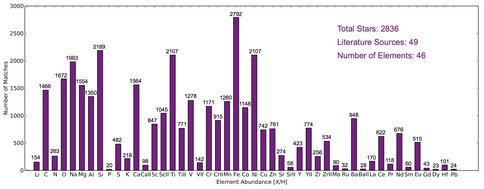2012 Annual Science Report
 Arizona State University
Reporting | SEP 2011 – AUG 2012
Arizona State University
Reporting | SEP 2011 – AUG 2012
Astrophysical Controls on the Elements of Life, Task 7: Update Catalog of Elemental Ratios in Nearby Stars
Project Summary
We have created the first complete database of bioessential elements for the stars closest to the Sun, including those hosting exoplanets.
Project Progress
This project is completed. One manuscript describing the Hypatia Catalog was submitted for publication in the Astronomical Journal, and a second manuscript applying the Hypatia Catalog to exoplanet hosts is about to be submitted. Graduate student Natalie Hinkel graduated in December 2011, and Dr. Hinkel started a postdoctoral scholar position with the NASA Exoplanet Science Institute at Caltech.
The first manuscript compiled spectroscopic abundance data from 50 literature sources for 46 elements across 2836 stars in the solar neighborhood, within 150 pc of the Sun, to produce the Hypatia Catalog (see Figure 1). We analyzed the variability of the spread in abundance measurements reported for the same star by different surveys, the corresponding stellar atmosphere parameters adopted by the various abundance determination methods, and the effect of normalizing all abundances to the same solar scale. The large number of stellar abundance determinations in the Hypatia Catalog also allows us to quantify the magnitude of the scatter about the mean abundance trend for each element (see Figure 2). No systematic correlations were found between stellar abundances and position, distance, or velocity. The standard abundance figures showing [X/Fe] with respect to [Fe/H] are consistent with other catalogs as well as modern chemical evolution models. The Hypatia Catalog has a wide number of applications, including exoplanet hosts (second manuscript in preparation), thick and thin disk stars, or stars with different kinematic properties.
Figure 1 – Number of stars in the Hypatia Catalog with measured abundances for 46 elements (from Hinkel et al, 2012, submitted).
Figure 2 – [P/Fe] (left) and [Mo/Fe] (right) ratio for stars in Hypatia as a function of [Fe/H], with a representative observational uncertainty in the upper right. Median values are used when multiple catalogs list different abundance levels. The radial distance of the host-star colors each abundance value. Blue triangles show the average abundance ratio value from all abundance values, not just the median, for three [Fe/H] bins: < 0.2 dex, [−0.2, 0.2] dex, and > 0.2 dex. The errorbar for each triangle is smaller than the size of the triangle. There are few measurements for [P/Fe], due to the difficulty in measuring IR spectral lines from ground-based telescopes (from Hinkel et al, 2012, submitted).
-
PROJECT INVESTIGATORS:
-
PROJECT MEMBERS:
Margaret Turnbull
Co-Investigator
Natalie Hinkel
Doctoral Student
-
RELATED OBJECTIVES:
Objective 1.1
Formation and evolution of habitable planets.
Objective 7.2
Biosignatures to be sought in nearby planetary systems

![[P/Fe] (Left) and [Mo/Fe] (Right) Ratio for Stars in Hypatia](../../../../media/site-content/reports/2012/asu/3eb31e617d36682fce25212fe80b63c6_timmes_task7_2012_fig2.jpg.484x0_q85.jpg)
